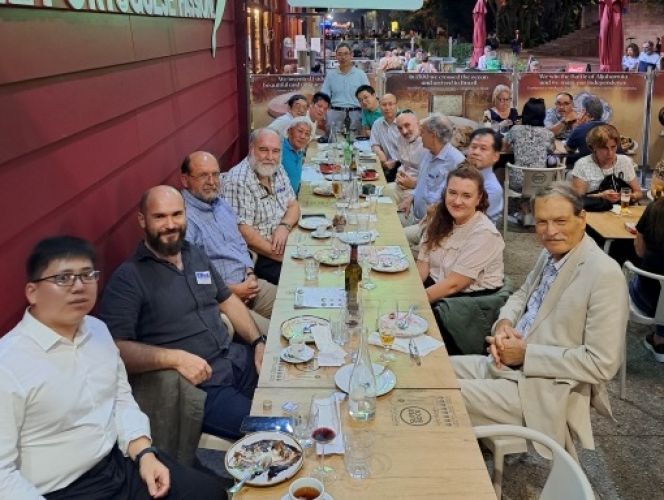BEM/MRM 46
46th International Conference on Boundary Elements
and other Mesh Reduction Methods
![]()
3-5 October 2023
Lisbon, Portugal
Overview

The 46th International Conference on Boundary Elements and other Mesh Reduction Methods took place in Lisbon Portugal. The conference was organised by the Wessex Institute, UK, represented by Dr Stavros Syngellakis, the Embry-Riddle Aeronautical University, USA, represented by Dr Eduardo Divo, the University of Central Florida, USA, represented by Professor Alain Kassab, and the University of Mississippi, USA, represented by Dr Alexander Cheng.
The conference, which started in 1978, is well-established and always attracts a wide international spread of delegates. Theoretical advances and new foundations have been reported at the conference for more than 40 years, helping to expand the range of applications as well as the type of materials in response to industrial and professional requirements. This ability to evolve is reflected in the history of the conference which has ensured the success of the meetings as well as the establishment of a community of stakeholders.
Opening of the Conference
The conference was opened by Dr Alexander Cheng who welcomed the delegates to the conference, then Dr Stavros Syngellakis introduced Wessex Institute to the audience, mentioning that the main object of WIT is the dissemination of knowledge, with particular emphasis on science and engineering. Another way in which this is achieved is by the publication of papers from conferences through its publishing arm, WIT Press.
Presentation of the George Green Medal
Following the opening of the conference, Dr Alexander Cheng conducted the George Green Medal Ceremony and awarded this year’s medal to Professor Ferri Aliabadi, Imperial College London, UNITED KINGDOM. Subsequently, Professor Aliabadi gave a keynote address on “Fracture across scales”.
Invited Speakers
There were a series of invited lectures on advanced topics of research and applications, as follows:
- “Boundary element-based dosimetry methods for the assessment of human exposure to radiation from 5G mobile systems”, by Professor Dragan Poljak, University of Split, CROATIA
- Analysis of planar skin model exposed to dipole antenna radiation featuring the use of MOM-MOM approach”, by Dr Mario Cvetković, University of Split, CROATIA
- “Determining the defect locations and sizes in elastic plates by using the artificial neural network and boundary element method”, by Professor Yijun Liu, Southern University of Science and Technology, CHINA
- “Physical-informed kernel functions: collocation discretizations and neural networks”, by Professor Zhuojia Fu, Hohai University, CHINA
- “Quadrature rule for solving the Helmholtz equation in hypersingular BEM formulation”, by Dr Antonio Romero Ordonez, University of Seville, SPAIN
- “Meshless Methods for Multiscale Hemodynamics with GPU Acceleration”, by Professor Alain Kassab, University of Central Florida, USA
- “A meshless solution combined with the DRBEM for plate buckling analysis”, by Mr Alberto Rangel, Pontifical Catholic University of Rio de Janeiro, BRAZIL
Keynote Speakers
- “A novel method for estimating deformation and stress fields in layered composites induced by internal defects and external environmental loads”, by Professor Ernian Pan, National Yang Ming Chiao Tung University, TAIWAN
- “Analytical evaluation of hypersingular integrals obtained while modelling heat diffusion and wave propagation in the presence of cracked media”, by Professor Antonio Tadeu, Itecons - University of Coimbra, PORTUGAL
- “Real- and complex-variable implementations of the consistent boundary element method in two-dimensional elasticity: a comparative assessment” by Dr Ney Dumont, Pontifical Catholic University of Rio de Janeiro, BRAZIL
- “Progress of mesh reduction methods” by Professor Xiao-Wei Gao, Dalian University of Technology, CHINA
- “Modeling of fire resistance and mechanical performance of glass facades” by Professor Kim Meow Liew, City University of Hong Kong, HONG KONG
Conference Sessions
The papers were divided into a series of sessions under the following headings:
- Damage mechanics and fracture
- Electrical engineering and electromagnetics
- Design optimisation and inverse problems
- Advanced formulations
- Computational methods
- Fluid flow modelling
Conference Publication
Papers presented at this conference will appear in Vol. 135 of the WIT Transactions on Engineering Sciences (ISSN 1743-3533). Papers presented at the meeting will be available Open Access in the eLibrary of the Wessex Institute (https://www.witpress.com/elibrary) from where they can be freely downloaded by any interested parties.
EABE Editorial Board Meeting
At the end of the second day of the Conference, members of the Editorial Board of the International Journal of Engineering Analysis with Boundary Elements (EABE) met to discuss how the publication is progressing and ways in which its performance versus other journals on Computational Methods in Engineering can be improved.
Following the meeting, members of the Board had dinner at the Restaurant D' Bacalhau serving traditional Portuguese cuisine.
Conference Dinner
The Conference dinner took place at Cantinho do Avillez - Parque das Nações, where the participants could enjoy the best contemporary Portuguese cuisine, including an exceptional range of traditional starters. The restaurant offered beautiful views over the Tangus River and the nearby Vasco da Gama Bridge, the longest bridge in Europe. The evening was particularly appreciated by the participants.
Closing of the Conference
The conference was closed by Dr Alexander Cheng, who thanked the delegates for attending and hoped that they would consider attending the next conference in the series which is planned to be reconvened in Seville, in September 2024.



 Wessex Institute
Wessex Institute